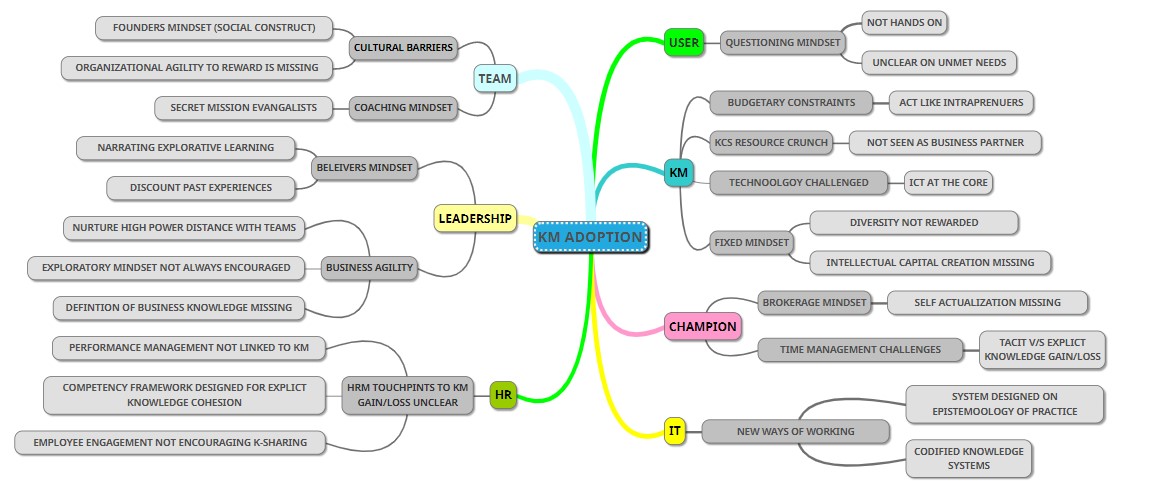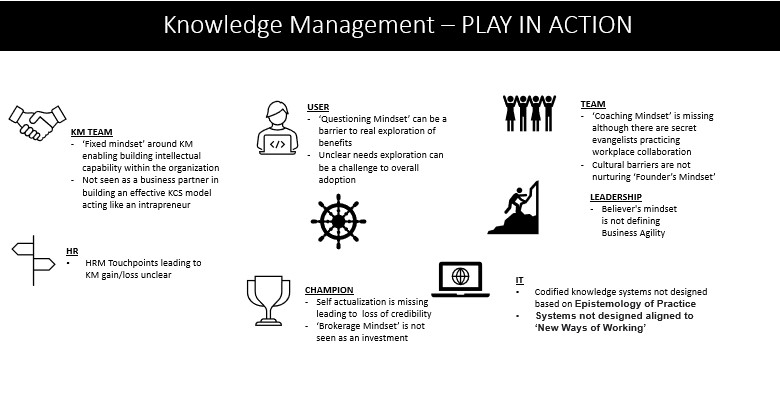...
How would you like to be a Guest Blogger for KMI? Email us at: info@kminstitute.org and let us know your topic(s)!
In Contempt of Knowledge Management
"All the world's a stage, and all the men and women merely players: they have their exits and their entrances; and one man in his time plays many parts, his acts being seven ages." - William Shakespeare
Ever wondered who the actors of a PLAY are when you are deploying a successful KM strategy? If you thought that it is only the Leaders who are the producers and who own the budget, then think again!
Today, there are the three categories we can put these ACTORS into:
1) Decision Makers : These are the stakeholders who are accountable and own the change at an enterprise , department, or team level. For example, the Leadership Team and their regional or geographic teams if KM is distributed model.
2) Influencers : These are key experts whose span of influence ensures the KM strategy is aligned to the culture of the firm. They are consulted with and at times responsible for coaching / mentoring the team implementing the change. For example, the HR collaborating with the Users who are early adopters of KM.
3) Implementers : These are the key to executing the change and are custodians of driving the outcomes and always ensuring that they advance those unclear on their KM needs to become believers. For example, the Champions working with the core KM team AND in-turn KM tram working with IT teams.
Past studies would tell you that Knowledge Management is an organizational need and yet it is inherent that most organizations discount how their KM strategy is aligned to the business strategy. One reason that comes to mind is how do we combine the culture + systemic design + user needs and equate it to designing KM systems around our business outcomes.
"The greatest deception men suffer is from their own opinions."
- Leonardo da Vinci

In the beginning of this article, we bucketed our actors into three categories. If you look at the above graphic, what does it call-out? We can further group the characteristics into the below. It tells you that before you build a KM system what becomes vital is to ensure you have agreed on a set-rule based policy of advancing KM within your organization; that encourages only certain behaviours that ensure knowledge is created - shared - used and harvested. It tells you that we also need to ensure we imbibe practices that encourage us to move from our Fixed Mindset to truly contributing to advancing information that is actionable and helpful to those in need of it, which is Knowledge.
Behaviours
- We ensure at an individual level we are clear on the user's unmet needs and ensure our KM team and Champions are working together to even challenge their own 'Fixed Mindset'. We need to provide them with the right budget approvals, empowerment to be decision makers in this journey as entrepreneurs and ensure they are rewarded for the softer aspects that lead to creation & sharing of intellectual capital.
- As leaders, we combine our own ‘Believer's Mindset’ and ensure through sharing of our own failures of adopting KM we encourage exploratory learning within our teams. We define how we want Knowledge Management to truly differentiate us.
- Ensure our teams have a 'Founders mindset' (social construct is not missing) to coach their teams and top-down we ensure workplace collaboration rather than advancing secret mission evangelists who are stand-alone heroes.
Practices
- It is important that workplace policies are aligned, and the HR manage knowledge gain-loss throughout the employee life cycle, including ensuring every event includes knowledge sharing to begin, which slowly encourages other leaders to come forward and avoid high-performance distance within their teams.
- Core KM team has a mix of diversity for ensuring there is no brokerage mindset within the champions and other influencers who are driving KM based on only how they are rewarded.
Knowledge
- Our systems need to be designed around epistemology of practice ensuring the IT team is not only considering the 'New Ways of Working' but ensuring that the right touchpoints are catered to codify the knowledge as it flows through the organization.
- Ensure ICT is at the core so we can ensure that everyone in the organization experience contributes to building an intuitive driven performance management system that advances how knowledge is truly an intangible asset that is a key differentiator.
In summary, we need to ensure we go beyond and ensure all our metrics are based around measuring employee engagement and employee effectiveness where the employee is not necessarily only the end-user consuming the knowledge.
So, let us all sign the petition to ensure we are clear on the critical KM touch points and partner with HR / and others based on the role they are playing for increasing adoption.
Disclaimer : This article is based on my own experiences and are my personal views. I hope you enjoyed reading it and this would help you investing in reading more on how KM.
~~~
About the Author : Michael Sequeira is an independent consultant who is passionate about helping organizations discover how KM can be a key differentiator for their business, teams, and clients. If you would like to learn more about his background and get-in-touch you can connect with him on LinkedIn.
Archives
- April 2024 (4)
- March 2024 (4)
- February 2024 (4)
- January 2024 (3)
- December 2023 (2)
- November 2023 (2)
- October 2023 (3)
- September 2023 (3)
- August 2023 (6)
- July 2023 (4)














